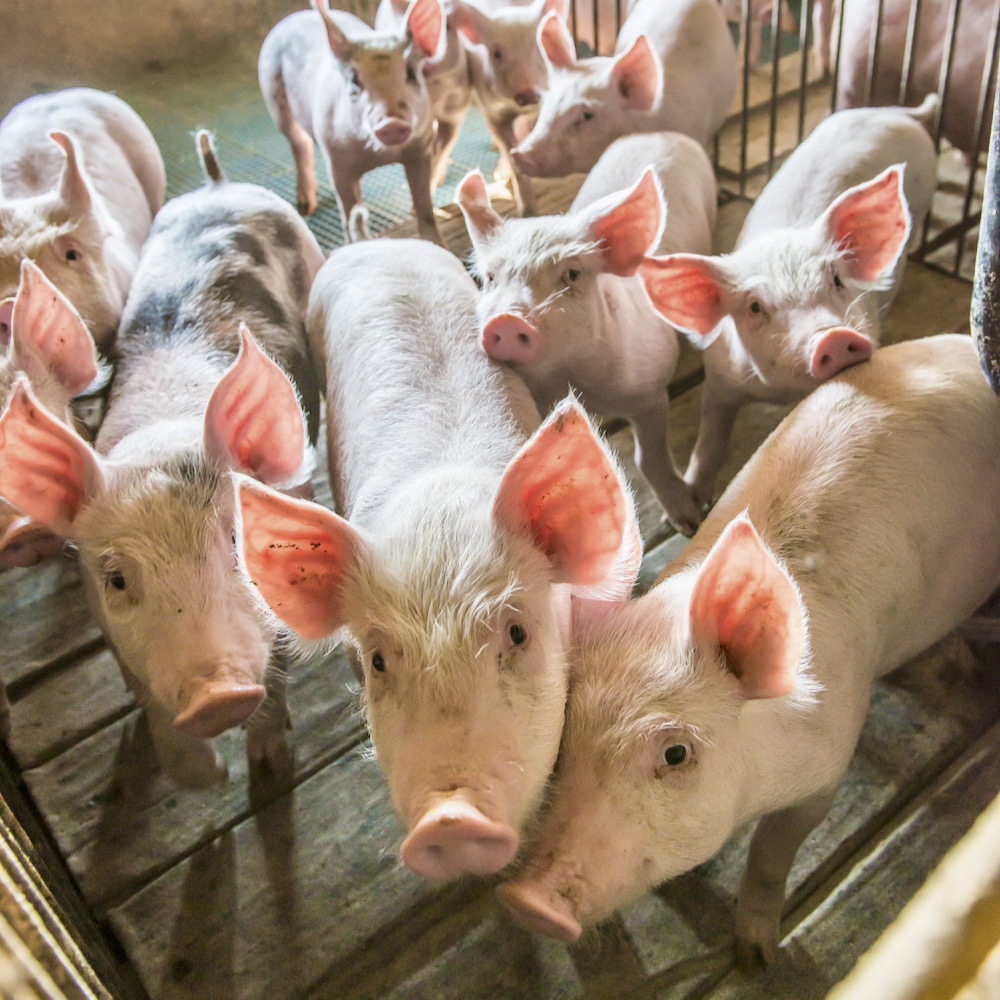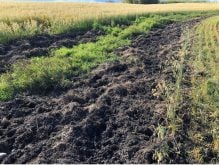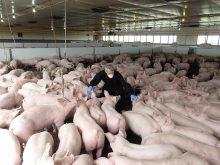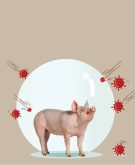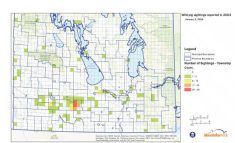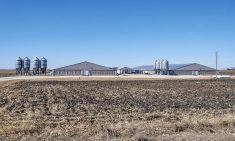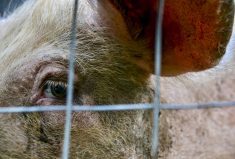Canada’s pork industry and border authorities are double and triple checking their vigilance after African swine fever (ASF) officially broached the Western Hemisphere for the first time in four decades.
In late July, the Dominican Republic confirmed ASF on backyard pig operations in two provinces. The Caribbean country announced that efforts were underway to isolate and contain the virus, including the ban of pig and pork movement in affected regions, epidemiological investigations, military checkpoints, farm quarantines, disinfections and slaughter of backyard pigs on farms where ASF was found.
Read Also

Pig transport stress costs pork sector
Popular livestock trailer designs also increase pig stress during transportation, hitting at meat quality, animal welfare and farm profit, Agriculture and Agri-Food Canada researcher says
As of Aug. 4, the list of provinces with ASF infections had expanded to 11.
Why it matters: Struggles against ASF in places like Europe and Asia, as well as devastating market impacts, have made ASF one of the pork sector’s biggest bogeymen.
Canada, along with the U.S. and Mexico, quickly announced tightened border inspections around airports. The U.S. Department of Agriculture noted that classic swine fever restrictions meant pork from the Dominican Republic was already banned in the U.S., but added there would also be increased scrutiny around Puerto Rico.
On July 29, the Canadian Food Inspection Agency (CFIA) released a statement saying it was “closely monitoring the situation in the Dominican Republic and working with Canada Border Services Agency (CBSA) to strengthen the appropriate border controls for the Caribbean.”
Although the CFIA has noted that Canada does not trade pork with the Dominican Republic, the ASF confirmation was met with dismay from industry.
“There’s significant concern,” said Cam Dahl, general manager of the Manitoba Pork Council.
He added, however, that he is pleased with the increase in scrutiny “of travellers coming in not only from the DR (Dominican Republic), but from all the Caribbean regions.”
“From a local perspective, this just really reinforces the need for very strict biosecurity protocols that are followed every time,” Dahl said.
The council has reached out to producers stressing existing biosecurity recommendations. In addition, according to Dahl, the producer’s group will be making extra effort to reach “the smallholders that, for example, might not be getting all of these messages.”
Dr. Egan Brockhoff, veterinary councillor with the Canadian Pork Council, said they have been meeting with Canada’s chief veterinary officer to stay abreast of anti-ASF efforts both at a national and international level — including co-operation with international bodies like the World Organization for Animal Health (OIE). They are also engaging with the CBSA and CFIA. Brockhoff says updates are happening “very nearly on a daily basis.”
Brockhoff noted that industry is not only worried about disease spread in the Dominican Republic, but the island — which it shares with Haiti — at large. If the virus gets established on the island, he noted, there is concern that inter-island movement may allow it to become established in the wider Caribbean.
“We’re worried then that, that could spill over into South America or Central Amercia or, absolutely worse-case scenario, North America,” Brockhoff said.
Wild pigs
Concern also dovetails with the increasing fight against invasive feral swine in the Prairies.
European countries have noted wild pigs as a vector for ASF, and the disease’s foothold in wild populations has complicated eradication effort. In mid-July, Germany reported its first on-farm cases of the deadly illness, in the same region that had previously seen over 1,200 cases reported in wild boar, Reuters reported at the time.
Even before the July cases, however, the presence of ASF in the wild population had led to trade barriers against German pork.
Locally, experts have noted — with alarm — a sharp rise in wild pig populations in Western Canada, and particularly since 2010.
Work out of the Canadian Wild Pig Research Project, led by Ryan Brook, has noted “high” instances of wild pigs (described as regions where evidence of wild pigs has been found 50 times or more) in several municipalities in southwestern Manitoba. Earlier this year, Brook suggested that some of those hot zones may be past the point of eradication, and may be better focused on containment.
“If he isn’t right, he’s very close to right,” Dahl said, although he added that he hopes eradication is still on the table. “The populations are growing. The potential for exponential growth is large.”
Dahl said he hopes the discovery of ASF in the Western Hemisphere might mean more attention to that fight.
Safety net
In Canada, the National Emergency Operations Centre for ASF has been active for over two years, following the start of devastating ASF outbreaks in Asia. Regional and national working groups have formed, focusing on everything from surveillance and traceability to biosecurity and deadstock disposal or strategies for excess hogs, should a local ASF case bottleneck the market.
The government of Canada, meanwhile, has been working to secure zoning agreements to maintain markets as much as possible in the face of ASF. Agreements have been reached with the U.S. and EU, while Brockhoff said there are talks with Singapore and continued work on “other key markets, such as Japan.”
“From a zoning perspective, we’ve been doing a lot of preparation. We’ve been doing a lot of practising here in Canada,” Brockhoff said. “We’re doing a lot of our homework. Now, it’s just continuing to engage with our international community on those bilateral trade agreements as we move towards finding more and more partners out there that are interested.”
The local pork sector, along with both the provincial and federal government, other provincial pork groups and the Canadian Pork Council are all “putting a lot of work into ensuring that, if the worst does happen, that we’re prepared and we’re prepared on that Day 1 to help producers through the crisis,” Dahl said.
Worse-case scenario
In the worst of worse-case scenarios — that of an ASF case right here in Canada, Brockhoff said the CFIA would firstly, and immediately, investigate and try to set out a primary control zone.
“If we find the virus quickly, that trace-back can rapidly tell us, ‘Do we have it contained?’” he said. “If the trace-back goes really easy, maybe we could establish a primary control zone within days, maybe it would take a little longer if the trace-back is a little more complicated.”
For example, he noted, the CFIA would face a much more intricate investigation if ASF cropped up at a major pork facility, which might see dozens of shipments from dozens of farms every day.
On top of the sheer labour of tracing those shipments and sending staff out to those farms, Brockhoff noted that ASF is relatively slow to spread through a barn, and investigators would have to do “a lot of sampling to be confident that you’re just not missing it, because the virus hasn’t moved fast enough yet.”
The pork sector would have some advantage compared to, for example, the BSE crisis that rocked the cattle sector for years after 2003 — a crisis from which Canada only shook off some of the last trade restrictions this year.
Unlike BSE, Brockhoff noted, there is the ability to test live animals for ASF, shaving time off the investigation and allowing industry to more actively seek out infections, rather than waiting for cases to appear.
Once the CFIA finalizes a control zone, reciprocal zoning agreements come into play to ensure countries that Canada has agreements with also recognize that control zone.
Should the virus crop up in the U.S., Canada would similarly respect the resulting U.S. control zone.
“I’m confident that the U.S. (would) contain the virus, just like Canada,” Brockhoff said. “We’ll be quick. We’ll be effective. They’ll move quickly to eradicate.”
But market slowdowns in the U.S. — driven by an ASF-positive rating from the OIE and resulting border closures against U.S. pork — would still hit hard at the Canadian market, even if the infection does not spread north of the border. Demand for Canadian pigs — such as the estimated three million piglets shipped south from Manitoba each year — would fall, Brockhoff noted.
“A positive in the United States is most likely going to have a very negative impact on the Canadian market in terms of pricing and it’s also going to have a really negative impact on pig movement right out of the gate,” he said.
Brockhoff further stressed the need for biosecurity, not only at the farm gate, but also at the border.






